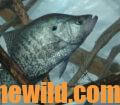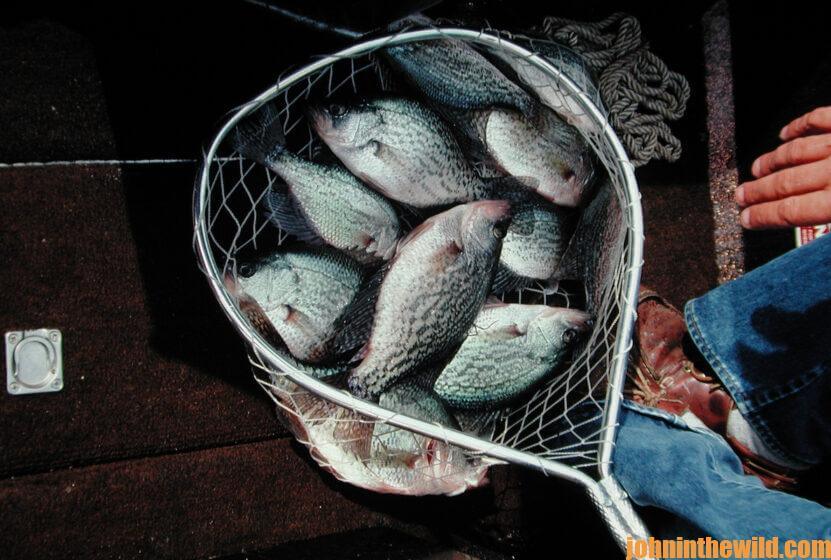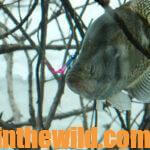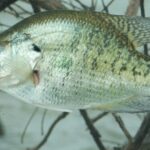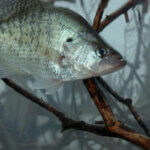Editor’s Note: Don’t bet on the crappie spawn in March, particularly if a cold front hits. Don’t spend your money or your vacation time on a fishing trip during March, expecting to find crappie spawning in shallow water. Although crappie usually spawn then, you may not locate them actively spawning and/or feeding in shallow water on the spring day you fish. I’ve learned strategies that help me take crappie almost every time I fish in the spring, and I always bet against the spawn. Let’s look at some ways to catch spawning crappie when they’re not holding in shallow water to lay their eggs.
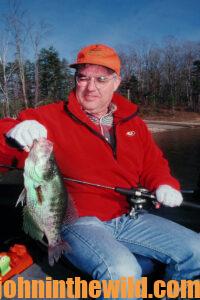 Fish Ditches:
Fish Ditches:
When Ruby Hughley of Paris, Tennessee, guided crappie fishermen on Kentucky Lake, before the spawn one year, she found a small ditch only 2-feet-deep right on the edge of a large, shallow-water spawning flat that had buck brush and other shallow-water cover in it where the crappie historically spawned. “I motored back and forth across the ditch, leaving buoy markers, and looked at my depth finder to learn that this ditch measured 6-feet wide, was 2-3 feet deep and about 60-yards long and held crappie,” Hughley said. “That year I began fishing the ditch before the spawn and caught large numbers of big crappie. Every time a cold front hit the lake, the fish moved into the ditch. Remember, not all the crappie spawned at the same time, and the female crappie might move to the bank two to four times before they spawned-out all their eggs. Ditches and cuts, secondary creek channels and other bottom breaks near spawning flats consistently produced more crappie than the spawning regions in the spring.”
Watch the Bridges:
During the spring, prior to the spawn when crappie swim up creeks looking for shallows, crappie often will hold on bridge pilings before moving to spawning flats. These bridge pilings provide vertical structure, a place to ambush baitfish and easy access to deep water for the crappie. When a cold front hits, or bad weather conditions force crappie to leave the spawning flats, many times crappie will return to the bridge pilings where they’ve stayed prior to the spawn, especially if the cold weather lasts for more than two days. On several occasions, I’ve caught numbers of crappie on the sides and on the downstream end of bridge pilings when cold weather has forced the spawning fish into deep water.
Don’t Forget Underwater Bridges:
Larry Bettison of Georgetown, Georgia, a sneaky, hot-weather crappie fishermen, rarely if ever lifts the lid on his ice chest or his livewell when someone asks, “Have you caught any fish?” Rather than lie, Bettison just wipes his brow and says, “The weather’s so hot out on the lake, I can’t believe a fish will bite anywhere.” But Bettison grins on the inside after his comment. He knows he has a cooler full of big slab crappie he’s caught at a time and at a place where most other anglers don’t fish during the summer months.
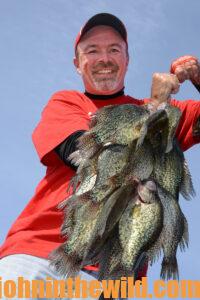
“Lake Eufaula in Eufaula, Alabama, near my home, has three or four underwater bridges that are still intact,” Bettison explained. “You can find these bridges by looking at old road and river maps that show train trestles and bridges crossing small creeks and rivers before the lake was impounded. Crappie often will suspend under these bridges and above these old creek channels. But even if you know crappie are holding around underwater bridges, you’ll have difficulty catching them unless you use two grappling hooks.” Bettison attempted to catch the underwater-bridge crappie for several years before he developed his grappling-hook technique. One bridge he fished lay out on the main part of the lake where waves caused his anchors to come up and moved his boat away from the edge of the bridge.
“I learned that if my minnows or jigs didn’t fall right beside the bridge where the crappie could see them, the fish wouldn’t move out from under the bridge to attack my baits,” Bettison reported. “If I anchored on top of the bridge and tried to fish the edge of the bridge, when the waves hit the boat, and the boat rocked, the anchors would come up off the top of the bridge and move my boat away from the edge of the underwater bridge. I couldn’t find a way to keep my line lying right along the edge of the underwater bridge so my minnow would put on a show for the crappie under the bridge.” Not one to accept defeat, Bettison came up with a grappling-hook tactic that would allow his boat to stay right on the lip of the break and let him fish with his line lying right beside and touching the old bridge.
“I made an anchor resembling a grappling hook from pieces of aluminum with a 4-foot piece of aluminum sticking straight up and four spikes coming off of the main shaft,” Bettison said. “I’d lower the grappling hook down and catch the underside of the bridge with at least two of the four prongs. Then I’d tighten-up on the rope and run the end of the rope through a bungee cord I’d hooked onto the cleat on the side of my boat. Once I got the first grappling hook secured to the side of the bridge, I’d hook up a second grappling hook to the stern. The grappling hook would hold the boat next to the bridge. The bungee cord let the boat rock back and forth without creating slack on the rope that held the grappling hook to the base of the bridge.
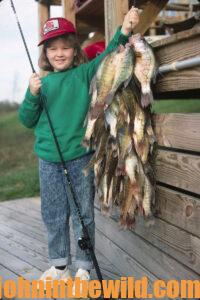 “Next, I baited my rods with live minnows and slowly let the lines down the side of the bridge. I kept most of my rods lying inside the boat with just the tips of the rods over the side of the boat. I usually could feel the side of the bridge with my line as I lowered a minnow down, so it could swim right on the bottom edge of the bridge where the crappie were holding. The bridge provided shade, structure and a place for the baitfish to concentrate.”
“Next, I baited my rods with live minnows and slowly let the lines down the side of the bridge. I kept most of my rods lying inside the boat with just the tips of the rods over the side of the boat. I usually could feel the side of the bridge with my line as I lowered a minnow down, so it could swim right on the bottom edge of the bridge where the crappie were holding. The bridge provided shade, structure and a place for the baitfish to concentrate.”
Although a number of people fish that bridge, Bettison has learned to fish a more-specific, productive place. Bettison fishes the edges of two pilings that sit on the underwater riverbank and support the span of the bridge. “Those bridge pilings offer vertical structure over the edge of the deep water, which means the crappie can hold vertically wherever they want under the shade of the bridge,” Bettison said. Often at night during the summer months, Bettison will use his grappling hooks to hold him on the break of the old underwater bridge. He finds that crappie move out from under the bridge and hold on top of the bridge when the sun goes in, and the moon comes out.
“The later I fish into the night, the closer to the surface I’ll catch crappie,” Bettison advised. “The fish will move up because I use either a Coleman lantern or floating lights to attract the baitfish on which the crappie will feed.” With Bettison’s grappling-hook method, he holds his boat on the lip of the break. He can fish the minnow either under the submerged bridge by day or on top of the bridge by night.
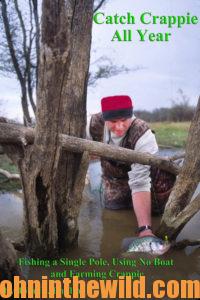 To learn more about crappie fishing, check out John E. Phillips’ book, “Catch Crappie All Year: Fishing a Single Pole, Using No Boat and Farming Crappie” in print, Kindle and Audible versions at http://amzn.to/1DBpnNh. You may have to copy and paste this link into your browser. (When you click on the books, notice on the left where Amazon says you can read and hear 10% of the book for free). On the right side of the page and below the offer for a free Audible trial, you can click on Buy the Audible book.
To learn more about crappie fishing, check out John E. Phillips’ book, “Catch Crappie All Year: Fishing a Single Pole, Using No Boat and Farming Crappie” in print, Kindle and Audible versions at http://amzn.to/1DBpnNh. You may have to copy and paste this link into your browser. (When you click on the books, notice on the left where Amazon says you can read and hear 10% of the book for free). On the right side of the page and below the offer for a free Audible trial, you can click on Buy the Audible book.
Tomorrow: Fish Cover & Make Set-outs for Crappie


